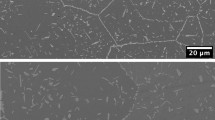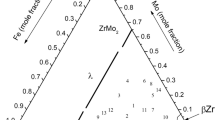Abstract
The origin of the solubility minimum of oxide (\( {M}_x\text{O}_y\)) in liquid Fe-M-O alloy was investigated, and the minimum was predicted based on thermodynamic calculations. Due to the characteristic property of activities of M and O in the liquid, a maximum exists in the product between the two activities if the affinity of M to O is significantly high, as most deoxidizing elements are. A critical activity product is defined, which is an indicator of the solubility minimum of the \( {M}_x\text{O}_y\) in the liquid Fe-M-O alloy according to the following relationship: \({{\text{max}}}(a_M^x \times a_{\underline{{{\text{O}}}}}^y) = {K_{M_x{{\text{O}}}_y}\times a_{M_x{{\text{O}}}_y}}\), where the \(a_{M_x{{\text{O}}}_y}\) is unity if the alloy is in equilibrium with the pure \(M_x{{\text{O}}}_y\). The origin of the solubility minimum was explained using the change of the activity product by composition. Available CALPHAD assessments for several binary Fe-M liquid alloys and Wagner’s solvation shell model were combined to calculate the activity product in the Fe-M-O alloy, which can be used to predict the solubility minimum of \( {M}_x\text{O}_y\). A favorable agreement was obtained when \(M = {\text{Al}}\), B, Cr, Mn, Nb, Si, Ta, Ti, V, and Zr. The Gibbs energy of dissolution of O in pure liquid M (\(\Delta g^\circ _{\underline{{{\text{O}}}}(M)}\)) and the Gibbs energy of the formation of \( {M}_x\text{O}_y\) per mole of atoms (\(\Delta g^\circ _{M_x{{\text{O}}}_y}/(x+y)\)) play important roles in determining the solubility minimum, as long as an interaction between Fe and M is less significant than the interaction between metal (Fe and M) and O. Predictions of the solubility minima of CaO and MgO were not satisfactory, requiring further improvement of the present analysis.












Similar content being viewed by others
Notes
\(\gamma _M\) also may be directly obtained by using commercial CALPHAD software and databases in which more sophisticated thermodynamic models may be employed to obtain a better description of \(g^{ex}\).
By applying Eq. [35] in the Fe-Al-O system, \(\gamma _{\text {O}}^\circ \) can be calculated as a function of Al content. Since \(a_{\underline{{{\text{O}}}}} = \gamma _{\text {O}}^\circ X_{\text {O}}\), \(X_{\text {O}} = \frac{a_{\underline{{{\text{O}}}}}}{\gamma _{\text {O}}^\circ } = a_{\underline{{{\text{O}}}}} (\sum _{i=0}^Z (\cdots ))\) where \(\cdots \) is the term inside the summation in Eq. [35]. This term is contributed from each solvation shell of i (i = 0 to 6 in the present study). Therefore, \(X_{\text {O}}\) has seven contributions from the seven different solvation shells, respectively. \(X_{\text {O}}\) from each contribution is normalized to the overall \(X_{\text {O}}\) (= \(a_{\underline{{{\text{O}}}}} (\sum _{i=0}^Z (\cdots )\)), and it represents the fraction of each solvation shell.
MnO forms a solid solution (Mn,Fe)O; therefore, the activity of the MnO(s) is not strictly at unity at equilibrium with a liquid Fe-Mn-O alloy. Therefore, the thermodynamic condition shown in Eq. [21] may need to be applied as:
$$\begin{aligned} {\text{max}}(a_{{\text{Mn}}}a_{\underline{\text{O}}}) = K_{{\text{MnO}}} \times a_{{\text{MnO}}} \end{aligned}$$However, \(a_{{\text{MnO}}}\) is not significantly lower than unity (\(> 0.99\)[60]), and finding the Mn content at the solubility minimum is not sensitive to the right-hand side of the above equation.
References
C. Wagner: Thermodynamics of Alloys, Addison-Wesley Pub. Co., Reading, MA, pp. 51–53, 1951.
G. Sigworth and J. F. Elliott: Met. Sci., 1974, vol. 8, pp. 298–310.
Japan Society for the Promotion of Science: in Steelmaking Data Sourcebook, Gordon & Breach Science, New York, NY, 1988.
C. Lupis: in Chemical Thermodynamics of Materials, Simon & Schuster (Asia) Pte Ltd, Singapore, 1993.
J. D’Entremont, D. Guernsey, and J. Chipman: Trans. Mec. Soc. AIME, 1963, vol. 227, pp. 14–17.
V. Shevtsov: Russ. Metall., 1981, vol. 1, pp. 52–57.
G. R. S. Pierre and R. Blackburn: Trans. Mec. Soc. AIME, 1968, vol. 242, pp. 2–4.
G. R. S. Pierre: Metall. Trans. B, 1977, vol. 8, pp. 215–217.
P.-W. Han, P.-X. Chen, and S.-J. Chu: High Temp. Mater. Proc., 2016, vol. 35, pp. 347–351.
M. Hone, S. Houot, and M. Rigaud: Can. Metall. Quart., 1974, vol. 13, pp. 619–623.
C.-G. Kuo: J. Alloys Comp., 2010, vol. 494, pp. 72–77.
G. R. Holcomb and G. R. S. Pierre: Metall. Trans. B, 1992, vol. 23, pp. 789–790.
S. S. Shibaev, P. V. Krasovskii, and K. V. Grigorovitch: ISIJ Int., 2005, vol. 45, pp. 1243–1247.
H. Itoh, M. Hino, and S. Ban-Ya: Tetsu-to-Hagane, 1997, vol. 83, pp. 773–778.
D. Bouchard and C. W. Bale: J. Phase Equil., 1995, vol. 16, pp. 16–23.
I.-H. Jung, S. Decterov, and A. D. Pelton: Metall. Mater. Trans. B, 2004, vol. 35B, pp. 493–507.
C. W. Bale and A. D.Pelton: Metall. Mater. Trans. A, 1990, vol. 21A, pp. 1997–2002.
A. D. Pelton: Metall. Mater. Trans. B, 1997, vol. 28, pp. 869–876.
M.-K. Paek, J.-J. Pak, and Y.-B. Kang: Metall. Mater. Trans. B, 2015, vol. 46, pp. 2224–2233.
A. D. Pelton, S. A. Degterov, G. Eriksson, C. Robelin, and Y. Dessureault: Metall. Mater. Trans. B, 2000, vol. 31B, pp. 651–659.
M.-K. Paek, J.-M. Jang, Y.-B. Kang, and J.-J. Pak: Metall. Mater. Trans. B, 2015, vol. 46B, pp. 1826–1836.
A. D. Pelton, and P. Chartrand: Metall. Mater. Trans. A, 2001, vol. 32, pp. 1355–1360.
G. Eriksson and A. D. Pelton: Metall. Trans. B, 1993, vol. 24, pp. 807–816.
D. Janke and W. Fischer: Arch. Eisenhüttenwes, 1976, vol. 47, pp. 195–198.
M.-K. Paek, K.-H. Do, Y.-B. Kang, I.-H. Jung, and J.-J. Pak: Metall. Mater. Trans. B, 2016, vol. 47, pp. 2837–2847.
C. Wagner: Acta Metall., 1973, vol. 21, pp. 1297–1303.
T. Chiang and Y. A. Chang: Metall. Trans. B, 1976, vol. 7, pp. 453–467.
R. Schmid, J.-C. Lin, and Y. A. Chang: Zeit. fuer Metall., 1984, vol. 75, pp. 730–737.
L. Pauling: The Nature of the Chemical Bond, Cornell University Press, Ithaca, NY, 1970.
S. Otsuka and Z. Kozuka: Metall. Trans. B, 1981, vol. 12, pp. 455–459.
Y. A. Chang, K. Fitzner, and M.-X. Zhang: Prog. Mater. Sci., 1988, vol. 32, pp. 97–259.
R. Hultgren, P. Desai, D. Hawkins, M. Gleiser, and K. Kelley: Selected Values of Thermodynamic Properties of Binary Alloys, ASM, Metals Park, OH, 1973.
B. Sundman, I. Ohnuma, N. Dupin, U. R. Kattner, and S. G. Fries: Acta Mater., 2009, vol. 57, pp. 2896–2908.
B. Hallemans, P. Wollants, and J. R. Roos: J. Phase Equil., 1995, vol. 16, pp. 137–149.
M. Selleby and B. Sundman: Calphad, 1996, vol. 20, pp. 381–392.
J.-O. Andersson and B. Sundman: Calphad, 1987, vol. 11, pp. 83–92.
J. Tibballs: in System Fe-Mg, European Communities, 1998, pp. 195–196
W. Huang: Calphad, 1989, vol. 13, pp. 243–252.
S. Liu, B. Hallstedt, D. Music, and Y. Du: Calphad, 2012, vol. 38, pp. 43–58.
J. Lacaze and B. Sundman: Metall. Trans. A, 1991, vol. 22, pp. 2211–2223.
S. Srikanth and A. Petric: J. Alloys Comp., 1994, vol. 203, pp. 281–288.
J. De Keyzer, G. Cacciamani, N. Dupin, and P. Wollants: Calphad, 2009, vol. 33, pp. 109–123.
K. Hari Kumar, and V. Raghavan: Calphad, 1991, vol. 15, pp. 307–314.
M. Jiang, K. Oikawa, T. Ikeshoji, L. Wulff, K. Ishida, J. Phase Equil. 22, 406–417 (2001)
C. W. Bale, E. Bélisle, P. Chartrand, S. A. Decterov, G. Eriksson, A. E. Gheribi, K. Hack, I. H. Jung, Y. B. Kang, J. Melançon, A. D. Pelton, S. Petersen, C. Robelin, J. Sangster, P. Spencer, and M.-A. Van Ende: Calphad, 2016, vol. 54, pp. 35–53.
M. Chase, ed.: in JANAF Thermochemical Tables, AIP, Woodbury, NY, 1985.
T. Kimura and H. Suito: Metall. Mater. Trans. B, 1994, vol. 25B, pp. 33–42.
S. Dimitrov, H. Venz, K. Koch, and D. Janke: Steel Res., 1995, vol. 66, pp. 39–43.
J.-D. Seo and S.-H. Kim: Steel Res., 2000, vol. 71, pp. 101–106.
K. Takahashi and M. Hino: High Temp. Mater. Proc., 2000, vol. 19, pp. 1–10.
L. Gu and Z. Tang: Acta Metall. Sinica, 1985, vol. 21, pp. A167–A174.
W. Fischer and D. Janke: Arch. Eisenhüttenwes, 1971, vol. 42, pp. 695–698.
W.-Y. Cha, T. Nagasaka, T. Miki, Y. Sasaki, and M. Hino: ISIJ Int., 2006, vol. 46, pp. 996–1005.
D. Kay and A. Kontopoulos, in Chemical Metallurgy of Iron and Steel: Proc. Int. Symp on Metallurgical Chemistry—Application in Ferrous Metallurgy, Iron and Steel Institute, London, 1971, pp. 178–183
R. Inoue, T. Ariyama, and H. Suito: ISIJ Int., 2008, vol. 48, pp. 1175–1181.
A. Ghosh and G. Murthy: Trans. ISIJ, 1986, vol. 26, pp. 629–637.
W. Liang: Zeit. fuer Metall., 1982, vol. 73, pp. 369–375.
Y. A. Chang and D. C. Hu: Metall. Trans. B, 1979, vol. 10, pp. 43–48.
K. Fitzner: Thermochimica Acta, 1982, vol. 52, pp. 103–111.
Y.-B. Kang and I.-H. Jung: J. Phys. Chem. Solids, 2016, vol. 98, pp. 237–246.
K. T. Jacob: Metall. Trans. B, 1981, vol. 12, pp. 675–678.
T. Narushima, K. Matsuzawa, Y. Mukai, and Y. Iguchi: Mater. Trans. JIM, 1994, vol. 35, pp. 522–528.
W. Huang: Calphad, 2004, vol. 28, pp. 153–157.
K. Jacob and C. Alcock: Acta Metall., 1972, vol. 20, pp. 221–232.
K. Fitzner and K. Jacob: J. Less Common Met., 1977, vol. 52, pp. 279–291.
S.-M. Liang and R. Schmid-Fetzer: J. Eur. Ceram. Soc., 2018, vol. 38, pp. 4768–4785.
Acknowledgements
The present author is grateful for the hospitality of Prof. P. Chartrand, École Polytechnique de Montréal, Canada, during his sabbatical stay. Constructive comments from Prof. Emeritus A.D. Pelton, École Polytechnique de Montréal, Canada, are also appreciated.
Author information
Authors and Affiliations
Corresponding author
Additional information
Publisher's Note
Springer Nature remains neutral with regard to jurisdictional claims in published maps and institutional affiliations.
Manuscript submitted February 18, 2019.
Rights and permissions
About this article
Cite this article
Kang, YB. Oxide Solubility Minimum in Liquid Fe-M-O Alloy. Metall Mater Trans B 50, 2942–2958 (2019). https://doi.org/10.1007/s11663-019-01663-4
Received:
Published:
Issue Date:
DOI: https://doi.org/10.1007/s11663-019-01663-4




